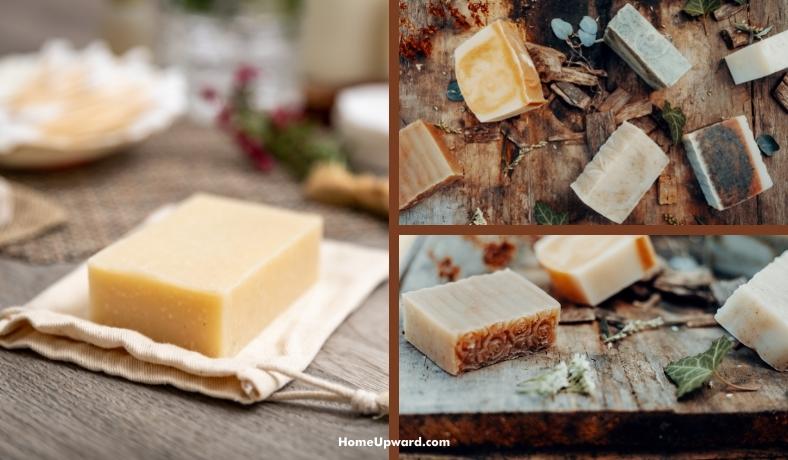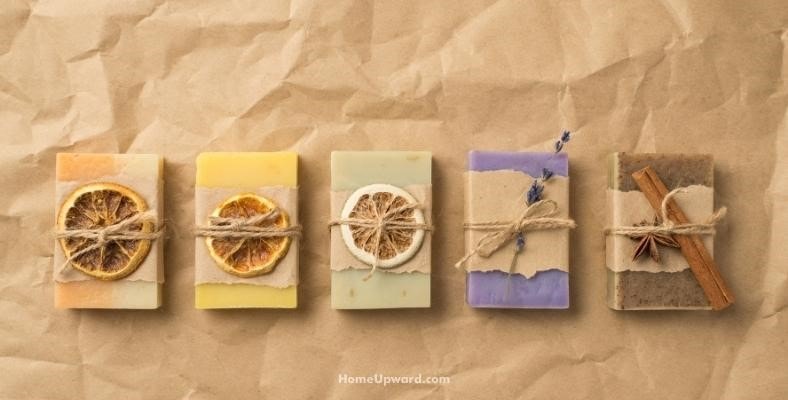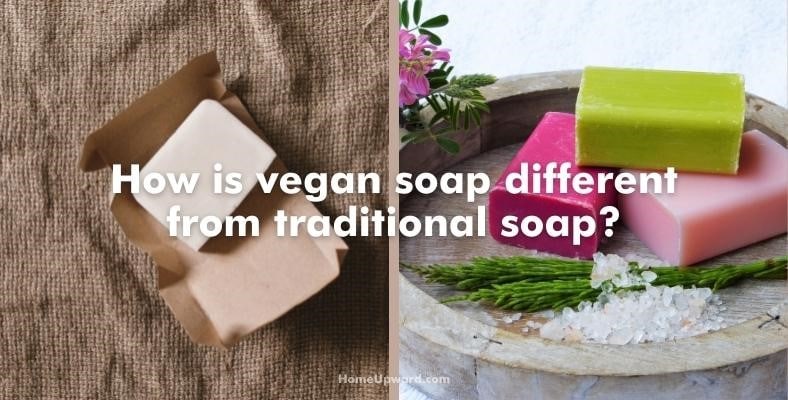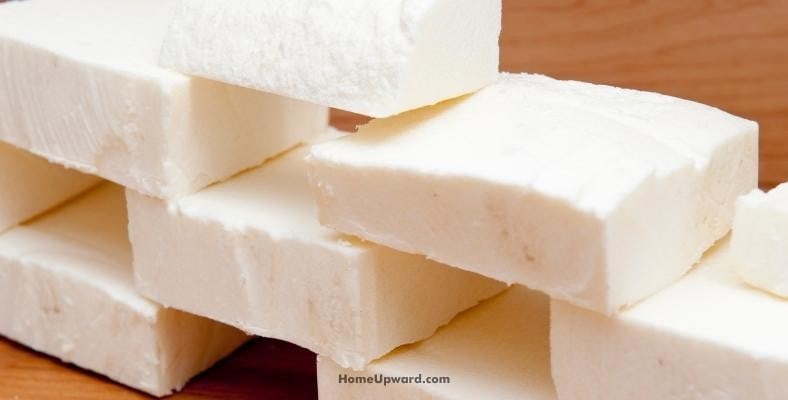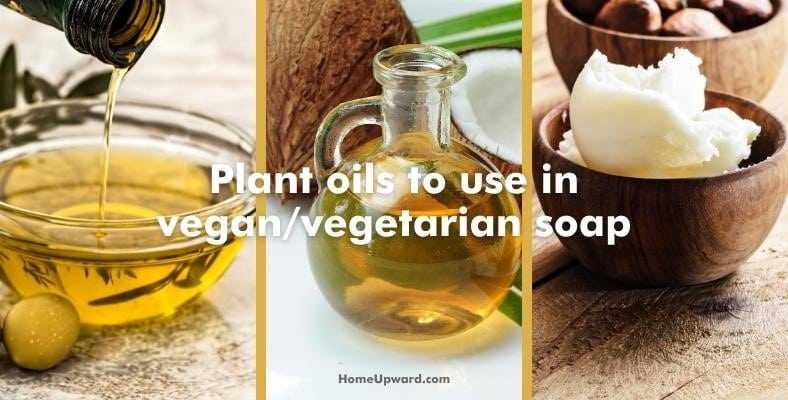Contents
What is Vegan Soap?
Vegan soap is soap made without any animal products or byproducts. It can be made with a variety of plant-based oils, and there are many different ways to make and process it. Like regular soap, it can be scented with essential oils.
In addition to vegan homemade soap, you can make your own natural shampoo from soap nuts to round out your DIY vegan soap needs!
How is Vegan Soap Different from Traditional Soap?
Vegan soap is made without using animal products. Traditional soap and most modern bar soaps are made using animal fat. During the soap making animal fat is mixed with sodium hydroxide (lye) and then goes through the process of converting the fat to soap (saponification).
When making traditional soap, the rendered form of beef or mutton fat (tallow) is mixed with the lye to reduce the corrosiveness of sodium hydroxide and process the fat into soap. When the tallow and lye are combined, sodium tallowate or soap is created.
Is Lye Vegan and Vegetarian?
Yes, lye and lye solutions are vegan and vegetarian. Lye is the name for two inorganic alkaline compounds, sodium hydroxide (NaOH) and potassium hydroxide (KOH). In the process of making traditional soap, the lye is completely vegan-safe, the tallow is the animal product.
Plant Oils to Use in Vegan/Vegetarian Soap
To make vegan or vegetarian soap, you need a plant-based oil to swap in place of the animal fat. Oil is a plant-based fat, so it can easily replace the animal fat in the traditional soap recipe. There are many plant-based oils out there, but these are the best for making vegan soap.
Olive Oil
While olive oil soap might sound strange, this rich oil helps moisturize the skin when made into soap or skin cleansers. Olive oil is also a common home remedy for skin rashes, eczema, and other painful conditions.
It’s a natural anti-inflammatory, and when applied to the skin, it should not irritate, even if you have sensitive skin. Homemade olive oil soap is the ideal makeup remover, sunburn remedy, and facial cleanser all in one.
Olive Oil Grades to Know
Before you rush out to purchase the most expensive bottle of olive oil you can find, it’s crucial to know the different grades of olive oil and what to know about each. Olive oil is made by pressing the entire olive (pit and all) and then spinning the paste (centrifuging) until the oil comes out.
The grades for U.S. olive oil are ranked below, from highest to lowest.
- U.S. Extra Virgin Olive Oil
- U.S. Virgin Olive Oil
- U.S. Virgin Olive Oil Not Fit For Human Consumption Without Further Processing
- U.S. Olive Oil
- U.S. Refined Olive Oil
Then there are the grades of olive-pomace oil. Olive-pomace oil is oil that is derived from the leftovers of the pressed extra-virgin olive oil. When the extra-virgin olive oil is spun out of the paste left from pressing the olives, the leftover pulp is wrung out to produce the pomace oil.
The grades for U.S. olive-pomace oil are ranked below, from highest to lowest:
- U.S. Olive-pomace Oil
- U.S. Refined Olive-pomace Oil
- U.S. Crude Olive-pomace Oil
The best olive oil for soap making is an oil with a very light flavor, color, and odor. This will ensure your soap will take on the properties that you want, like scent or texture, and it will prevent your bar soap from feeling oily or slimy and smelling strongly of olive oil.
Olive Oil Properties in Soap
Olive oil is a rich fatty acid that will moisturize and lather the skin when used in soap. It may be a great option for people with sensitive skin or issues with acne, rashes, or sunburns. Olive oil is ideal for making a hard, long-lasting soap that will condition your skin without leaving it filmy.
Coconut Oil
Another popular ingredient in cooking and skincare, coconut oil is made of 80-90% saturated fat, which keeps it solid at room and slightly warmer temperatures. The oil is sourced from the meat and milk of coconut, and when combined with lye, it makes a rich soap with a long shelf life.
Coconut Oil Properties in Soap
When made into soap, coconut oil can naturally cleanse your skin of bacteria, and it is an innate antifungal and antiviral. When made into a soap bar, the oil will bubble and lather when you scrub with it, which is rare for plant-based homemade soap.
Like olive oil, coconut oil will leave your skin feeling smooth and clean, though make sure to use a moisturizer as some soapmakers report drier skin after using coconut oil. If you have oily skin, this may be the perfect vegan soap solution for you.
Shea Butter
Shea butter is made from the nut of Vitellaria paradoxa (the shea tree). The fatty butter is a natural moisturizer, anti-inflammatory and antioxidant, making it an ideal ingredient for your soap mixture. It’s a very smooth butter that makes a great conditioner or face and body lotion.
For soapmaking, replacing fat with shea butter makes a soft and soothing soap. Shea butter soap can be a home cure for minor scrapes and burns and helps fade acne scars or stretch marks.
If kept in a dry place, shea butter soap can last for two years. It can be made in a soap mold or by the cold press method and made without lye if you’re looking for an all-natural, no chemicals soap.
Palm Oil
Palm oil comes from the fruit of the oil palm tree. An edible vegetable oil often used in baking and salad dressings, palm oil is also a common soapmaking ingredient. Palm oil isn’t always a popular choice on its own because it can dry out the skin if it isn’t put together with something richer.
However, it’s often put together with softer and more moisturizing oils like coconut oil or shea butter. Together, they make a hard, long-lasting bar of soap that both cleans and softens your skin.
Other Vegan Oils for Soapmaking
If palm oil, shea butter, coconut oil, or olive oil don’t sound right for your handmade soap batter, there are plenty of other vegan oils that have beneficial skincare properties and work well as animal fat replacements.
Below is our list of the best vegan oils for making handmade soap:
- Sunflower Seed Oil
- Jojoba Oil
- Almond Oil
- Grapeseed Oil
- Rosehip Oil
- Argan Oil
- Castor Oil
- Cocoa Butter
- Avocado Oil
How to Make Vegan/Vegetarian Soap
Making vegan or vegetarian soap is easier than you might think. It can be made using a cold process, in a soap mold, and with various scents and textures. To be vegan or vegetarian, your soap just needs a plant-based oil or butter as fat instead of a tallow.
Vegan Cold Process Soap
Cold process means the process of combining the oil of your choice with fat, also called saponification. To make sure your soap is vegan, choose the plant-based oil of your choice and blend it carefully with your measured lye solution and the amount of water you need.
Make sure to use a thermometer and scale to carefully measure the ingredients you’ll need for your cold process soap base. Lye is dangerous to handle, so wear gloves and other protective materials while you’re using it.
Your soap will take several weeks to cure before you can use it, so store it in a cool, dry place, as bar soap should be stored the right way for avoiding problems later.
Vegan Glycerin Soap
Vegan glycerin soap is made from a colorless, odorless, non-toxic liquid (glycerin) mixed with the vegan oil of your choice and whatever other ingredients you want in your soap base. Glycerin is a popular additive in beauty products; its moisture-locking properties make it a top choice for those struggling with dry skin.
Simple Vegan, Palm Oil Free Soap Recipe for Beginners
To make a vegan, palm oil free soap base, you’ll need:
- Lye
- Water
- Organic oil of your choice (not palm)
- Mask, gloves, and apron
Heat your oil on the stove, and then let it cool while you prepare the lye solution. Once your lye and water are measured out, carefully pour the lye into the water and stir slowly.
Mix the lye solution and the cooled oil, and blend until they’re fully incorporated.
At this stage, you can add your scents or other ingredients, and then it’s time to pour your soap into the mold. After 24 hours, take the soap out of the mold and put it somewhere cool and dry. In about six weeks your soap will be ready to use!
DIY Natural Wildflower Soap
When you’re making handmade soap, adding your aesthetic touch and flair to it is half the fun. To make DIY natural wildflower soap, add dried flowers to the bottom of your soap mold before pouring in the blended soap batter or the middle.
When you unmold your soap, the flowers will be on top or in the middle of your bar of soap, depending on where you placed them.
Homemade Shampoo Bar with Lavender and Clay
To make a homemade shampoo bar with lavender and clay, add the lavender essential oil and clay to your blended soap mix before pouring the mix into the mold. Using shea butter along with natural oils will create more shampoo-like lather than other soaps.
Rosemary and Peppermint Energizing Shower Soap
Rosemary and peppermint shower soap energizes and invigorates with a powerful scent while thoroughly cleaning the body with the herb’s natural odor-busting properties. This soap will leave you feeling fresh and polished.
Vegan Elderberry Soap
Vegan elderberry soap can be made by adding elderberry extract or essential oil to your soap batter after the blending stage. You can also add crushed, dried, or minced elderberries to bring texture and authentic scent to your soap.
Warm Cider Hot Process Soap Recipe
To make warm cider soap using a hot process, you will need
- 7 ounces olive oil
- 5 ounces organic Babassu oil
- 5 ounces cocoa butter
- .10 ounces stearic acid
- .50 ounces cranberry seed oil
- .75 ounces Winter Apple Candy BBW Type Fragrance Oil
- 5 ounces water
- 1-ounce apple cider, frozen
- 1 tablespoon applesauce
- 2.5 ounces lye

